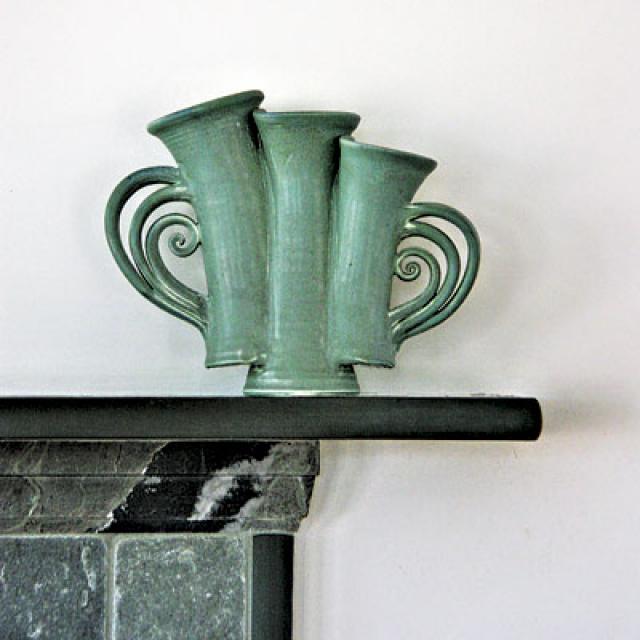Americana of the Ceramic Kind

Tucked away in East Hampton’s Georgica Estates condominium community, a light, bright, and airy house is aglow with the vivid colors of a formidable collection of midcentury American ceramics. For Max Pine and Lois Mander, who bought their house in 2003, the joy is in the objects themselves rather than their historic or monetary value. The colorful vases, bowls, dinnerware, and sconces lovingly arranged throughout the house are, in fact, not especially valuable and many of the pieces have no identification. “The value, to us, is as decorative items,” Ms. Mander said, surveying the dazzling colors arranged around her. “It’s really about the design, the color, the shape, and what’s decorative.” Mr. Pine, who also lives in New York, where he keeps a collection of more than 800 pencil sharpeners, was in Italy this month, but provided a virtual tour via email. “Color, shape, and glaze are what matter when selecting a piece for the collection,” Mr. Pine was president of Restaurant Associates, a provider of premium food services, from 1976 to 1993. Most of the collection, he wrote, was made between the 1930s and ’50s. About half of the collection was acquired in the Hamptons, Mr. Pine wrote, though the source will remain a secret. The antiques with which the house is furnished, Ms. Mander said, are almost exclusively local finds, such as a vintage china cabinet discovered in Sag Harbor. In the kitchen, it’s a perfect fit in a sun-drenched corner. “So it has a lot of California ‘fiesta ware,’ ” Ms. Mander said. “It also has a mixed potpourri of pottery: hot orange pitchers, plates with checkerboard rim and bright flowers. But again, it’s all about the color and the shape — and the utility. We use everything.” Abingdon, Roseville, Red Wing, and Royal Haeger are abundantly represented among the collection. Objects, such as vases — in soft pastels and differing sizes — tend to be grouped by color, though their placement is subject to whimsy. “Green and blue are my favorite colors,” Ms. Mander said, and complementary groups of vases in those colors and a multitude of shapes stand ready for floral arrangements. “We collected them because we love the shape and all of the colors,” she said. “Lois and I like having flowers in the house,” Mr. Pine wrote, “and she is always the one to choose just the right vase for them.” Originally, he wrote, the vases might have been purchased with flowers at a florist, “for less than a dollar.” “Lois has definite colors she likes or dislikes,” Mr. Pine added. “She spends more time arranging and rearranging the collection than I do. But the ability to completely change the displays is one of the joys of our collections.” Or, as Ms. Mander put it, “It’s an ongoing discussion.” All the ceramics are American-made, Mr. Pine wrote, as are the vibrant Boonton plastic bowls in the kitchen. But despite the emphasis on midcentury America, there are no rules to the furnishings here: candle holders by the English Art Deco ceramics designer Clarice Cliff are here, and a set of three sconces by the French ceramicist Annie Gnoli (nee de Garon), mother of the late painter Domenico Gnoli, form a vertical procession between the sunlight streaming through the windows on either side. Nonetheless, midcentury America is the clear theme, the audacious colors and daring outlines an unmistakable expression of a still-young nation’s brashness and confidence in its every move. At one time, Mr. Pine wrote, “every state had one or more ceramics factories.” “The whole point of this collection — in fact of the house — was to keep it local and light and decorate with what we couldn’t resist buying, mostly from the East End,” Ms. Mander said. “We buy an object because we love it, and if we don’t agree that we both love it, after 24 hours it gets returned.” “Max is a collector of many things,” she summarized. “But he loves design. More than anything, he loves shape, color, and good design.”
